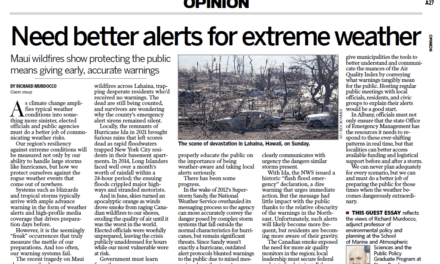The following was written by Karl Grossman, a friend of the Foggiest Idea.
Karl Grossman is professor of journalism at the State University of New York/College at Old Westbury and chief investigative reporter at Long Island’s WVVH-TV. And he’s the host of the nationally-aired TV program, Enviro Close-Up (www.envirovideo.com).
Have the lessons of Superstorm Sandy been learned?
I’d say no.
Indeed, governments from the federal level on down have largely reverted to the folly of decades ago when—with the U.S. Army Corps of Engineers in the lead—the notion was you could take on Mother Nature on the shoreline and win.
There’ve been some efforts at what is now being termed “strategic retreat” from the shore. But, otherwise, riding high is what’s become a post-Sandy slogan: “Stronger than the Storm.” It’s a variant of what former Suffolk County Executive John V. N. Klein decades ago called the Army Corps construction of stone jetties called groins along the Westhampton oceanfront—“hand-wrestling with God.”
Suddenly back is the Army Corps’ of Engineers scheme of 50-years ago—advanced when I came into journalism on Long Island—to dump massive amounts of sand along the shore from Fire Island Inlet to Montauk Point. In the original scheme, too, were those groins Klein opposed.
Public works czar Robert Moses in 1962 combined the Army scheme with his plan for a four-lane highway on roadless Fire Island. Writing about all this was my first major story as a reporter. Creation of a Fire Island National Seashore stopped the Moses road. And, as more became known about the science of coastal geology, the Army Corps plan was challenged and stalled (although the Westhampton groins got through)—until now.
Like a bad penny, it’s returned—and far more than pennies are involved. The price tag now for the Army scheme to mainly involve dumping sand (most of which will wash away in succeeding storms) on 83 miles of south shore Long Island is $700 million in taxpayer dollars. Congress has approved the scheme’s comeback. Governor Andrew Cuomo supports it.
A pioneer in coastal geology is Dr. Orrin Pilkey of Duke University who after Sandy struck wrote an op-ed piece in The New York Times headed “The Need to Retreat From the Beach.” He stated: “As ocean waters warm, the Northeast is likely to face more Sandy-like storms. And as sea levels continue to rise, the surges of these future storms will be higher and even more deadly. We can’t stop these powerful storms. But we can reduce the deaths and damage they cause…Yet there is already a push to rebuild homes close to the beach and bring back the shorelines to where they were.”
Dr. Pilkey said “this ‘let’s come back stronger and better’ attitude…is the wrong approach to the increasing hazard of living close to the rising sea. Disaster will strike again. We should not simply replace all lost property and infrastructure. Instead, we need to take account of rising sea levels, intensifying storms and continuing shoreline erosion.”
Building on the shore has being going on with intensity. The Economist magazine recently ran an article “You’re Going to Get Wet.” It noted: “Even as seas have risen over the past century, Americans have rushed to build homes near the beach. Storms that lash the modern American coastline cause more economic damage than their predecessors because there is more to destroy.”
There have been some sensible post-Sandy government efforts to buy out people whose beach houses were flattened by Sandy rather than having them rebuild and their beach house flattened again. But, overall, the response to Sandy has been to push for what R Street, a Washington, D.C. think tank, describes as “Beach House Bailouts.” Of sand-dumping on the shore, Eli Lehrer, R Street president, says it “creates a false sense of security that tends to induce development in the very areas where it’s most likely to be destroyed by nature’s worst.”
More than massive sand-dumping is back in Sandy’s wake.
Efforts at “hard stabilization”—through revetments, groins and similar structures—long shown to protect one section of beach but at great cost to another, are now seen again by some as a tool. Post-Sandy attempts by beach house owners in Southampton Village to go this route has made national news with a Page 1 New York Times story headed: “Dispute in Hamptons Set Off By Effort to Hold Back Ocean.” Southampton Village officials have taken a fancy to this approach.
There’s no holding back the ocean. Learning to live with Mother Nature, not wasting limited public money in a losing fight against her on the shoreline, is key.












